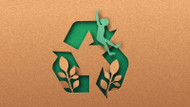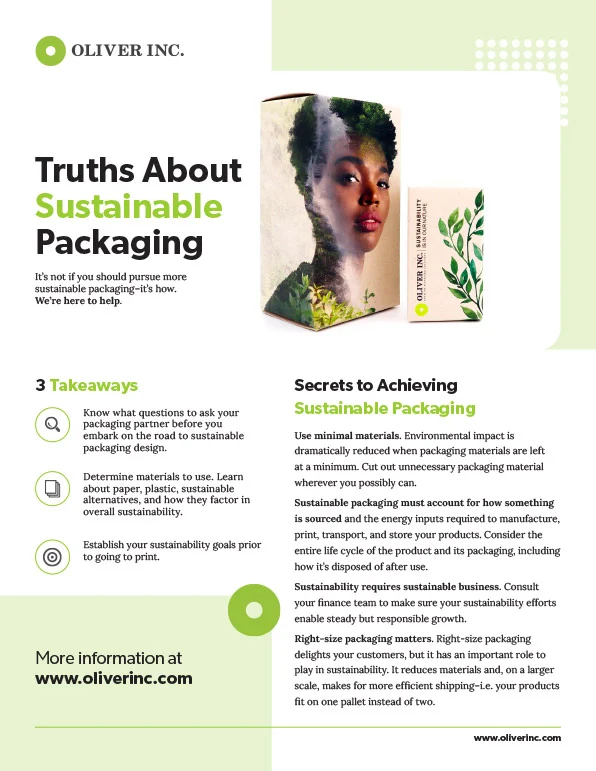Can You Recycle Cartons?
Posted by Oliver Inc. on 6th Oct 2022
Although local governments encourage residents and businesses to recycle all approved materials, there’s often confusion about whether certain packaging, such as cartons—particularly with foil treatments or waxy coatings—can be recycled.
So much so, this apprehension may lead to apathy, skepticism, or dissuade some from recycling it altogether.
As a rule of thumb, the majority of cartons are recyclable and are transformed into paperboard, building materials, and other sustainable items—but with a few exceptions, which we’ll outline below.
Whether you’re selecting the perfect sustainable packaging or promoting recycling after use, here are some important things to consider when it comes to encouraging your customers to recycle cartons.
Recycling Cartons: Process & Myths
From milk quarts to juice boxes, the majority of cartons are, indeed, recyclable, but different municipalities or recycling districts might accept or reject them at pick-up.
For the former, the process of user recycling is as easy as 1-2-3, states the Carton Council, a nonprofit dedicated to expanding carton recycling:
-
Drain the carton of any remaining liquid or food.
-
Toss the carton into the recycling bin without flattening it, and if it has a cap or straw (such as a juice box, for example), just leave it screwed on or poke it back into the container.
-
Kick it to the curb on your designated recycling day.
Some communities without access to a materials recovery facility (MRF) do not accept cartons—as MRFs are key to sorting and shipping to paper mills—yet some nonprofits and other groups are stepping in to fill this gap.
Carton Council, for example, accepts such shipments, and will recycle cartons for households.
Although recycling reduces air and water pollution, saves energy, and mitigates greenhouse gas emissions, there are still several misconceptions regarding its overall value.
Some call into question whether the majority of paper products actually end up in landfills. According to the Environmental Protection Agency (EPA), paper and paperboard accounted for the largest percentage (23.05%) of municipal solid waste (MSW) in 2018, and 66.54% of total recycled MSW. That’s a lot of paper!
Others hesitate to recycle window cartons or packaging with waxy coatings (a thin layer of polyethylene or plastic)—both of which can be recycled into lower paper grades and building materials, according to the Carton Council.
Not only can cartons be recycled, but doing so is crucial to paperboard production and sustainability. More than half (50.2%) of worldwide paper and board production utilizes recycled fibers, reads a 2018 analysis from global federation the Bureau of International Recycling (BIR).
Environmental Impacts
Since the United Nations (UN) began promoting circular economies in 2015, global entities have incentivized product reuse, rather than utilizing virgin materials and further exhausting valuable resources.
With the average American using an estimated 650 pounds of paper annually, repurposing the majority of these resources into recycled white paper creates 75% less processed energy, 74% less air pollution, and 35% less water pollution, reads a Massachusetts Institute of Technology (MIT) analysis.
Every ton of recycled pulp saves 17 trees, 7,000 gallons of water, 3 cubic yards of landfill space, 390 gallons of oil, 4,200 kilowatt hours (enough to heat a house for six months), and lessens 60 pounds of air pollutants, it states.
Cartons, in particular, are optimal materials for building, given their inherent moisture and mold resistance. For example, sustainable roof cover board manufacturer Continuus Materials converts recycled paper and plastics into high-performing building materials—utilizing about 400 cartons to make every 4’x8’ material board, and each truckload saving nearly 300,000 from landfills.
As 94% of the natural resources used by Americans are non-renewable, recycling plays a crucial role in lessening pollution, energy, greenhouse gas emissions, and other global warming contributors.
Tips About Promoting Recyclability of Your Cartons
To help your packaging contribute to positive environmental impacts, there are a few things you can do to promote recycling:
1. Avoid overdoing foil as a decorative touch.
If putting foil logos on a paper box, not to worry—it can still be recycled. However, mylar foil paper used to line a box can’t. Keep foil layer coverage to less than 40%, as anything more will likely prevent recycling equipment from identifying it as such, and improperly sort.
2. Clearly instruct users on how to recycle your cartons.
To cut through any recycling confusion or ambivalence, keep it simple with your consumers: Let them know if and how your packaging can make it into the bin for pick-up.
3. Choose materials that promote recycling.
When selecting the right sustainable packaging to set your brand apart, choose materials such as paper, cardboard, or other fibers with limited environmental impact, and reduce plastic usage, if you can.
4. Tie the recyclability of your cartons into your sustainability story.
Sharing your sustainable packing story creates brand affinity with eco-conscious customers and helps connect you with like-minded vendors. Plus, it’s part of your whole story. You can share it by synergistically guiding users with visual cues, such as clear symbols, instructions, or QR codes that link them to more information about your commitment to sustainability.
Work With Oliver Inc.
From the store shelves, to recycling bins, and beyond, sustainable packing stands out to consumers today, throughout the world.
With certifications from the nonprofits Sustainable Forest Initiative (SFI), Forest Stewardship Council (FSC), and Programme for the Endorsement of Forest Certification (PEFC), Oliver helps you outline and exceed your packaging goals with sustainable material selection and design.






